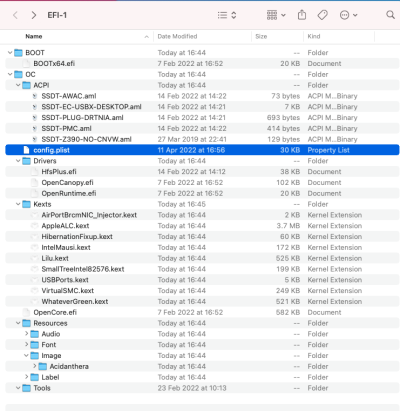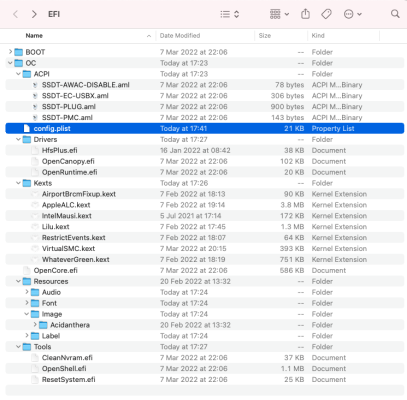Edhawk
Moderator
- Joined
- Aug 2, 2013
- Messages
- 6,326
- Motherboard
- Asus ROG Strix X570-F Gaming
- CPU
- Ryzen 9 3900X
- Graphics
- RX 6700 XT
- Mac
- Mobile Phone
I have also reviewed your OpenCore EFI folder and decided to create a new EFI for your system. Copy attached below.
This new OpenCore EFI is set for your Coffee Lake system, using the following:
The two EFI folders don't look that different, as can be seen in the two screenshots below.
 Current EFI folder contents.
Current EFI folder contents.
 New EFI folder contents.
New EFI folder contents.
Given my previous post what I have not included in the EFI is your current USBPorts.kext. That would defeat the object of creating a new/clean boot loader, as I see things.
I also removed the AirPortBrcm4360_Injector.kext plugin from AiportBrcmFixup.kext included in the /EFI/OC/Kexts folder. As there are other parts to the AirportBrcmFixup.kext that you weren't using in your previous setup.
I would recommend you do the following:
This new OpenCore EFI is set for your Coffee Lake system, using the following:
- iMac19,1 SMBIOS - newly generated and checked agains Apple Support, it is not used by a real Mac.
- Intel Framebuffer for IGPU to run in headless mode, alongside natively supported Nvidia dGPU.
- Config.plist, kexts, drivers and tools for OpenCore 0.7.9
- Resources folder for Acidanthera GoldenGate GUI boot screen.
- SecureBootModel for Big Sur/Monterey.
The two EFI folders don't look that different, as can be seen in the two screenshots below.
 Current EFI folder contents.
Current EFI folder contents. New EFI folder contents.
New EFI folder contents.Given my previous post what I have not included in the EFI is your current USBPorts.kext. That would defeat the object of creating a new/clean boot loader, as I see things.
I also removed the AirPortBrcm4360_Injector.kext plugin from AiportBrcmFixup.kext included in the /EFI/OC/Kexts folder. As there are other parts to the AirportBrcmFixup.kext that you weren't using in your previous setup.
I would recommend you do the following:
- Copy this EFI folder to the EFI partition on a spare USB pen drive, do not change anything in this EFI.
- Boot your system from the pen drive not your normal macOS drive.
- Press the F12 key when the Gigabyte screen logo appears and select the UEFI partition on the USB drive from the Bios Boot Menu.
- You will need to use the ClearNvram.efi and ResetSystem.efi tools when you get to the OC Boot screen. This is so any previous entries in the Nvram are removed and you don't end up using mixed settings.
- These tools will be hidden by default on the OC boot screen, just press the Spacebar to display these and two other tools.
- When you use the ResetSystem tool the system will reboot, part of clearing the Nvram.
- So you will have to select the USB pen drive from the Bios Boot Menu again, by pressing the F12 key at the correct moment.
- When you boot macOS from the pen drive EFI you should see the verbose kext from the system, then the Apple Logo and progress bar. Hopefully this will then result in the Login screen being displayed.
- If a KP occurs take a photo and post a copy here so we can see what is causing the kernel panic.

